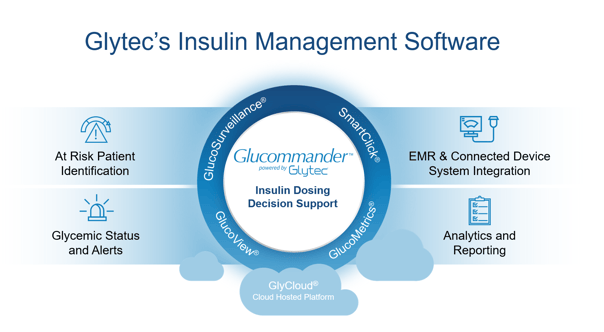
Subcutaneous (subQ) insulin is a “high-alert” medication according to the Institute for Safe Medication Practices (ISMP), meaning that it bears a heightened risk of causing significant patient harm when used in error.
Healthcare providers are often intimidated by insulin, in particular for fear of hypoglycemia, and rightly so: A 2014 ISMP survey found that pharmacists and nurses ranked subQ insulin the No. 9 drug of most concern out of 39 high-alert medications, and they ranked it in last place compared to the others when asked how confident they were in their system’s safety precautions.
Recognizing that hospitalized patients are vulnerable to errors with subQ insulin and that more needs to be done to prevent patient harm, ISMP published guidelines for optimizing safe subcutaneous insulin use in adults in 2017. And because Glytec prioritizes patient safety, our eGlycemic Management System (eGMS) has specific capabilities that can help hospitals follow these guidelines.
According to the ISMP guidelines, the following have been identified as “targeted priority areas of risk” concerning subQ insulin:
Clearly, administering subQ insulin comes with a long list of potential risks. Thankfully, Glytec’s eGMS can help hospitals address many of these priority risk areas, especially as they relate to dosing and administration.

ISMP risk areas addressed:
eGMS modules that address these risk areas:
At the center of Glytec’s eGMS is Glucommander, FDA-cleared software that delivers personalized insulin dosing recommendations at the point of care.
Glucommander SubQ replaces sliding scale only for insulin dosing. With options for basal/bolus+correction, basal+correction and basal/insulin:carb ratio+correction, the Glucommander SubQ algorithm provides effective, personalized dosing recommendations that improve patient safety and help providers achieve the standard of care.
Glucommander integrates with popular EMRs through its SmartClick module and can replace outdated or confusing insulin order sets. And unlike digitized sliding scale order sets, which simply carry over outdated methodologies into the EMR, Glucommander helps improve patient outcomes in addition to reducing errors by adjusting dosing recommendations based on real-time data.
Together, these features allow hospitals to promote the adoption of standard-of-care basal/bolus insulin (BBI) therapy.
In fact, eGMS has been proven to improve BBI adoption: use of eGMS helped improve BBI utilization at one medical center from 5% to 96%.
Further reading: IV Insulin: Pharmacy’s Role in Reducing Risks
How eGMS Can Help Improve SubQ Insulin Administration
ISMP risk areas addressed:
eGMS modules and features that address these risk areas:
In addition to improving dosing decision making, Glytec’s eGMS can also improve SubQ insulin administration and decrease the likelihood of dangerous errors.
Using SmartClick, blood glucose test results and key clinical data points such as patient weight are automatically imported into Glucommander, so doctors and nurses don’t have to manually enter data — a key to reducing the risk of transcription errors.
GlucoView provides a centralized display of primary glycemic status indicators for all patients in a designated unit, helping improve care team coordination. With GlucoView, nurses can easily track last BG test results and current infusion rates and see precisely when the next check is due. This can help improve testing frequency to ideal cadence and reduce errors due to miscommunication, especially during the handoff between shifts.
GlucoSurveillance interfaces with the laboratory information system to perform continuous real-time analysis of blood glucose values for patients who aren’t currently on Glucommander, alerting providers to patients who would benefit from insulin therapy. Meanwhile, the Glucose Velocity Warning alerts nurses about sudden drops in patient blood sugar, helping to proactively prevent hypoglycemic events.
Through the combined use of Glucommander’s toolset, preventable insulin-related adverse drug events are mitigated. A study at one Florida hospital demonstrated that by reducing errors like stacked doses and wrong doses, eGMS decreased preventable hypoglycemia-related adverse drug events by 62.6%.
Glytec’s eGMS addresses many of the risks associated with prescribing and administering subQ insulin. In conjunction with other initiatives, this technology can help hospitals follow the ISMP guidelines for optimizing safe subcutaneous insulin use in adults.
ECO #0948-A

©2024 Glytec, LLC | Terms of Use | Legal Disclaimer | Privacy Policy | Contraindications, Warnings and Precautions
The eGlycemic Management System® is a modularized solution for glycemic management across the care continuum that includes Glucommander®. Glucommander® is a prescription-only software medical device for glycemic management intended to evaluate current as well as cumulative patient blood glucose values coupled with patient information including age, weight and height, and, based on the aggregate of these measurement parameters, whether one or many, recommend an IV dosage of insulin, glucose or saline or a subcutaneous basal and bolus insulin dosing recommendation to adjust and maintain the blood glucose level towards a configurable physician- determined target range. Glucommander® is indicated for use in adult and pediatric (ages 2-17 years) patients. The measurements and calculations generated are intended to be used by qualified and trained medical personnel in evaluating patient conditions in conjunction with clinical history, symptoms, and other diagnostic measurements, as well as the medical professional’s clinical judgement. No medical decision should be based solely on the recommended guidance provided by this software program.
Glucommander® is only available for use in the United States.
This site is only intended for use in the United States.